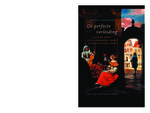De perfecte verleiding
Muzikale scènes op het Amsterdams toneel in de 17e eeuw
Abstract
Music; Stage presentations; History of Amsterdam In de zeventiende eeuw ging vrijwel iedere toneelvoorstelling gepaard met muziek. Er werd niet alleen gemusiceerd tussen de bedrijven, maar ook in het toneelstuk zelf. Muziek diende als achtergrond en versiering en was functioneel geïntegreerd in de handeling van het drama. Uit de rekeningen van de Amsterdamse Schouwburg blijkt dat men professionele musici in dienst had; daarnaast werd er gezongen en gedanst door de acteurs. In navolging van buitenlandse toneelmuziekstudies wordt in dit boek voor het eerst uitvoerig aandacht besteed aan de zeventiende-eeuwse theatermuziek in de Nederlanden. Centraal staat de toneeldichter Jan Harmensz Krul, die de muziek op vakkundige manier in zijn toneelstukken verweefde en die in 1634 de Amsterdamse Musyck-kamer oprichtte - een stichting die geheel gewijd was aan het samengaan van poëzie en muziek op het toneel. Aan de hand van vijf karakteristieke muzikale scènes uit zijn werk (de wachterscène, gevangenisscène, serenade, offerscène en slaapscène) wordt een beeld geschetst van de toenmalige Amsterdamse toneelmuziekpraktijk. Zulke muzikale scènes waren ook geliefd bij andere toneeldichters, in binnen- en buitenland. Zij hadden voor het publiek een signaalfunctie: het waren direct herkenbare situaties, ijkpunten in het drama, die standaard met muziek werden geassocieerd. Dichters varieerden hierop naar hartelust. Voor toneelschrijver en toeschouwer waren die stereotiepe muzikale scènes wat muziek was voor de personages in de toneelstukken: een effectief middel om te manipuleren - een perfecte verleiding, van oog, oor en hart.
Keywords
history of amsterdam; theater; music; stage presentations; muziek; geschiedenis van amsterdamDOI
10.5117/9789053566763ISBN
9789053566763OCN
437106773Publisher
Amsterdam University PressPublisher website
https://www.aup.nl/Publication date and place
2004Classification
Theatre studies
Music
History


 Download
Download